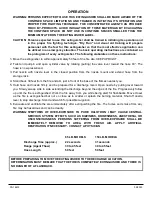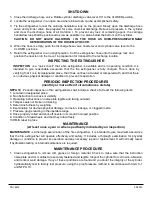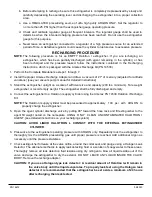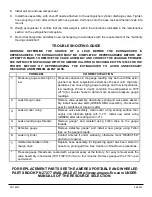
PN 16672
04/2020
SHUTDOWN
1.
Close the discharge hose valve. Rotate cylinder discharge valve lever 90° to the CLOSED position.
2.
Locate the extinguisher in an open area where blow down can be accomplished safely.
3. Tip the extinguisher to rest the carriage handle/tow loop on the ground. Slowly open the discharge hose
valve and cylinder valve. Be prepared for some chemical discharge. Relieve all pressure in the cylinder
and clear the discharge hose of all Halotron l. To prevent any loss of remaining agent, the carriage
handle/tow loop shall be positioned as low as possible in a plane below the bottom on the cylinder.
CAUTION: DO NOT LEAVE HALOTRON l IN THE HOSE AS OVER
-
PRESSURIZATIONAND
DETERIORATION OF THE HOSE MAY OCCUR.
4.
When the hose is empty, push the discharge hose valve nozzle lever and cylinder valve lever to the
CLOSED positions.
5.
Return the extinguisher to an upright position. Coil the extinguisher hose onto the storage rack and
position the nozzle onto the mount in preparation for transport to the recharge location.
INSPECTING THE EXTINGUISHER
INSPECTION
is a
“
quick check
”
that a fire extinguisher is available and is in operating condition. It is
intended to give reasonable assurance that the fire extinguisher is fully charged. This is done by
verifying that it is in its designated place, that it has not been actuated or tampered with, and that there
is no obvious physical damage or condition to prevent its operation.
PERIODIC INSPECTION PROCEDURES
(monthly or more often if circumstances dictate)
NFPA 10
-
Periodic inspection of fire extinguishers shall include a check of at least the following items:
1.
Located in designated place
2.
No obstruction to access or visibility
3.
Operating instructions on nameplate legible and facing outward
4.
Tamper seals not broken or missing
5.
Determine fullness by weighing
6.
Examination for obvious physical damage, corrosion, leakage, or clogged nozzle
7.
Pressure gauge reading in the operable range
8.
Hose properly coiled and shut
-
off nozzle in its mount in closed position
9.
Condition of tires/wheels and that they rotate freely
10.HMIS label in place
MAINTENANCE
(At least once a year or when specifically indicated by an inspection)
MAINTENANCE
is a thorough examination of the fire extinguisher. It is intended to give maximum assurance
that the fire extinguisher will operate effectively and safely. It includes a thorough examination for physical
damage or condition to prevent its operation and any necessary repair or replacement. It will normally reveal
if hydrostatic testing or internal maintenance is required.
MAINTENANCE PROCEDURE
1.
Clean extinguisher to remove dirt, grease or foreign material. Check to make sure that the instruction
nameplate and UL manifest are securely fastened and legible. Inspect the cylinder for corrosion, abrasion,
and dents or weld damage. If any of these conditions are found and you doubt the integrity of the cylinder,
hydrostatically test to factory test pressure, using the proof pressure method in accordance with CGA C
-
1
and NFPA 10.









